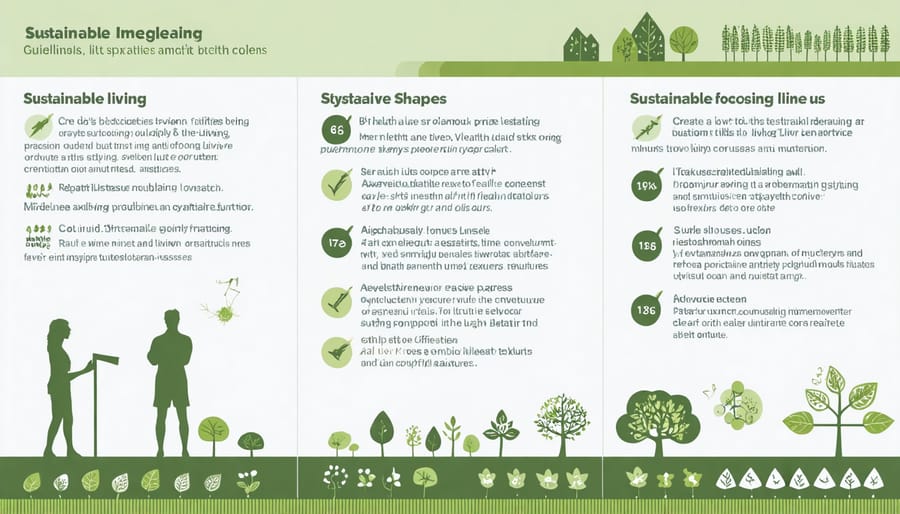Environmental wellness stands at the intersection of personal health and planetary sustainability, fundamentally shaping our physical and mental well-being in ways we’re only beginning to fully understand. The quality of our surroundings—from the air we breathe to the spaces we inhabit—directly impacts our health outcomes, stress levels, and overall quality of life. Research shows that individuals who actively improve their environmental wellness experience reduced anxiety, better sleep patterns, and enhanced immune function.
The relationship between our environment and health isn’t just about clean air and water—it encompasses our immediate living spaces, workplace conditions, and access to natural environments. As urbanization accelerates and climate challenges mount, understanding and optimizing our environmental wellness becomes increasingly crucial for maintaining both individual health and community resilience. By recognizing this connection and taking proactive steps to create healthier environments, we invest not only in our own well-being but in the sustainable future of our planet.
The Deep Connection Between Your Environment and Health
Physical Health Impacts
The quality of our environment directly impacts our physical health in numerous ways. Poor air quality can lead to respiratory issues, allergies, and breathing difficulties, while exposure to pollutants may increase the risk of heart disease and certain cancers. Clean water access is essential for preventing waterborne illnesses and maintaining proper hydration.
Living in areas with excessive noise pollution can raise blood pressure and stress levels, potentially contributing to cardiovascular problems. Chemical exposure from household products, pesticides, and industrial emissions may affect our endocrine system and immune function.
On the positive side, environments rich in natural elements promote physical activity, better sleep patterns, and stronger immune systems. Access to green spaces encourages regular exercise, while natural sunlight helps maintain healthy vitamin D levels and supports proper circadian rhythms. Clean, well-maintained living spaces reduce the risk of infections and respiratory issues, demonstrating how our immediate environment plays a crucial role in our physical well-being.
Mental Health Benefits
Environmental wellness plays a crucial role in our mental health, contributing significantly to holistic environmental well-being. Research shows that people who maintain a strong connection with their environment experience lower stress levels, reduced anxiety, and improved mood. Natural settings, in particular, have been found to decrease cortisol levels and promote mental clarity.
Spending time in well-maintained, clean spaces helps reduce mental fatigue and enhances cognitive function. Whether it’s a organized home office or a peaceful garden, our surroundings directly influence our psychological state. Studies indicate that individuals who regularly interact with nature and maintain environmentally conscious practices report higher levels of life satisfaction and emotional resilience.
The simple act of caring for plants, recycling, or participating in community clean-up efforts can provide a sense of purpose and accomplishment, contributing to improved self-esteem and reduced symptoms of depression. This connection between environmental stewardship and mental well-being demonstrates why maintaining a healthy relationship with our environment is essential for overall psychological health.
Your Home Environment and Health
Air Quality
Indoor air quality plays a crucial role in our overall health and wellness, affecting everything from our respiratory system to our cognitive function. Most Canadians spend approximately 90% of their time indoors, making the quality of indoor air a significant factor in our environmental wellness.
Poor indoor air quality can trigger various health issues, including allergies, asthma, headaches, and fatigue. Common indoor air pollutants include volatile organic compounds (VOCs) from cleaning products, mold spores, dust mites, and carbon dioxide from poor ventilation. These pollutants can accumulate to levels significantly higher than outdoor air, especially in well-sealed modern buildings.
Maintaining good indoor air quality involves several practical steps. Regular ventilation by opening windows, using air purifiers, and maintaining proper humidity levels (between 30-50%) can significantly improve air quality. Choosing low-VOC products, regularly cleaning air filters, and incorporating air-purifying plants like spider plants or peace lilies can also help create a healthier indoor environment.
By prioritizing indoor air quality, you can create a healthier living space that supports your physical health, mental clarity, and overall well-being.

Organization and Stress
A well-organized living space can significantly impact your mental health and overall wellness. Research shows that cluttered environments increase cortisol levels, the body’s primary stress hormone, leading to anxiety and decreased focus. When your surroundings are chaotic, your mind often mirrors that disorder, making it harder to relax and maintain emotional balance.
Creating an organized environment helps reduce mental fatigue and improves decision-making abilities. Simple actions like maintaining a clean desk, establishing dedicated spaces for different activities, and implementing effective storage solutions can help create a sense of control and calm in your daily life.
Studies indicate that people who maintain tidy living spaces generally experience better sleep quality, reduced stress levels, and improved productivity. This organization extends beyond physical cleanliness – it includes creating systems that make daily tasks more manageable and establishing routines that support your wellness goals.
Consider starting small by organizing one area at a time, such as your bedroom or home office. This gradual approach prevents overwhelming feelings and allows you to build sustainable organizational habits that contribute to your overall environmental wellness.
Nature’s Role in Your Wellness Journey
Green Space Benefits
Spending time in natural green spaces offers remarkable benefits for both physical and mental well-being. Research shows that regular exposure to nature can lower blood pressure, reduce stress hormones, and boost immune system function. Parks, gardens, and forests provide clean, oxygen-rich air that helps improve respiratory health and overall vitality.
These natural environments encourage physical activity through activities like walking, hiking, and cycling, contributing to better cardiovascular health and weight management. Studies indicate that people who regularly visit green spaces are more likely to meet recommended physical activity guidelines and maintain a healthy lifestyle.
Green spaces also play a crucial role in mental health. Time spent in nature has been linked to reduced anxiety and depression symptoms, improved mood, and enhanced cognitive function. The natural environment helps restore mental energy, improve concentration, and boost creativity. Even brief encounters with nature, such as a 15-minute walk in a park during lunch break, can provide meaningful benefits.
For children, access to green spaces supports healthy development, improves attention span, and reduces the risk of behavioral issues. These natural settings also create opportunities for social connection and community engagement, further contributing to overall wellness.

Outdoor Activities and Health
Engaging in outdoor activities plays a vital role in enhancing environmental wellness while providing significant health benefits. Regular outdoor exercise and recreation help strengthen our connection with nature while improving both physical and mental well-being.
Spending time outdoors increases vitamin D levels naturally through sunlight exposure, which is essential for bone health and immune system function. Activities like hiking, cycling, or gardening not only provide excellent cardiovascular exercise but also help reduce stress levels and improve mood through exposure to natural environments.
Research shows that people who regularly participate in outdoor activities experience lower rates of anxiety and depression compared to those who primarily exercise indoors. The natural environment offers unique sensory experiences that can’t be replicated inside, such as fresh air, natural sounds, and varying terrain that challenges different muscle groups.
Green spaces and natural environments also promote social connections through community activities and group outdoor pursuits. Whether it’s joining a local hiking group or participating in community garden projects, these activities foster both environmental awareness and social bonds, contributing to overall wellness.
Environmental Responsibility and Personal Health
Sustainable Living Practices
Making eco-friendly lifestyle choices not only benefits the environment but also significantly impacts our personal health and well-being. By adopting proven health prevention strategies that include sustainable living practices, we can create healthier living spaces while protecting our health.
Using natural cleaning products reduces exposure to harmful chemicals that can irritate respiratory systems and trigger allergies. Growing your own food or choosing organic produce decreases contact with pesticides while providing fresher, more nutritious options. Installing proper ventilation and air filtration systems helps maintain better indoor air quality, reducing the risk of respiratory issues and improving overall wellness.
Energy-efficient homes not only lower utility bills but also create more comfortable living environments with consistent temperatures and better air circulation. Using sustainable transportation methods like walking or cycling increases physical activity levels while reducing air pollution exposure. Choosing eco-friendly building materials and furniture reduces off-gassing of harmful compounds, creating a healthier indoor environment.
Creating a chemical-free garden provides a therapeutic outdoor space while supporting local biodiversity and improving air quality around your home. These sustainable choices contribute to both environmental protection and personal health improvement, making them essential components of overall wellness.

Community Environmental Impact
The health of our environment directly impacts the wellness of our communities, creating a ripple effect that touches every aspect of our lives. When communities maintain clean air, water, and green spaces, residents experience better physical and mental health outcomes. Studies show that neighborhoods with more trees and parks have lower rates of respiratory illnesses and stress-related conditions.
Environmental wellness at the community level also fosters social connections and promotes active lifestyles. Well-maintained walking trails, community gardens, and public parks encourage physical activity and provide spaces for neighbors to interact, building stronger social bonds and support networks.
Communities that prioritize environmental health often see reduced healthcare costs and improved quality of life for residents. For example, areas with lower air pollution levels report fewer cases of asthma and cardiovascular disease. Additionally, green initiatives like community recycling programs and local farmers’ markets promote sustainable practices while supporting local economies.
By participating in community environmental efforts, individuals can contribute to collective well-being while enhancing their own health. Simple actions like supporting local environmental initiatives, participating in community clean-ups, or joining environmental advocacy groups can make a significant difference in creating healthier, more sustainable neighborhoods for everyone.
Environmental wellness is a fundamental aspect of our overall health and well-being that deserves our immediate attention and action. Throughout this article, we’ve explored how our environment directly impacts our physical health, mental well-being, and quality of life. By taking steps to improve our environmental wellness, we can create positive changes that benefit both ourselves and our planet.
To enhance your environmental wellness, start with small, manageable changes in your daily routine. Consider walking or cycling for short trips, reducing single-use plastics, and creating a green space in your home. Make conscious choices about the products you use, focusing on environmentally friendly options that minimize harmful chemicals and waste.
Remember that environmental wellness is interconnected with other aspects of health. By maintaining a clean, sustainable environment, you’re not just protecting nature – you’re investing in your physical health, reducing stress, and creating a healthier future for coming generations.
Take action today by choosing one area to focus on, whether it’s improving your home’s air quality, starting a small garden, or reducing your carbon footprint. Every positive step, no matter how small, contributes to better environmental wellness and a healthier life for all.

